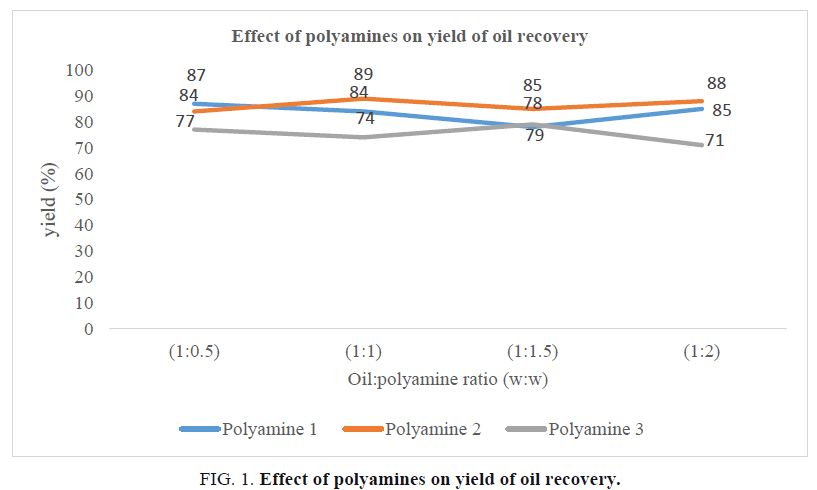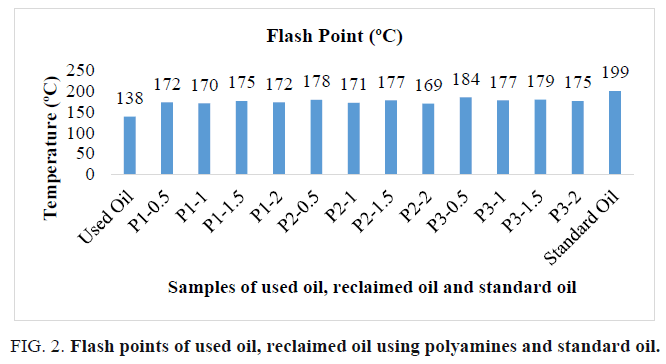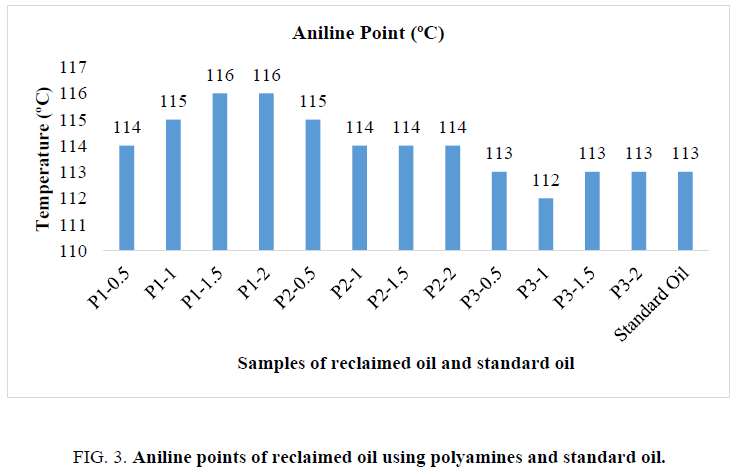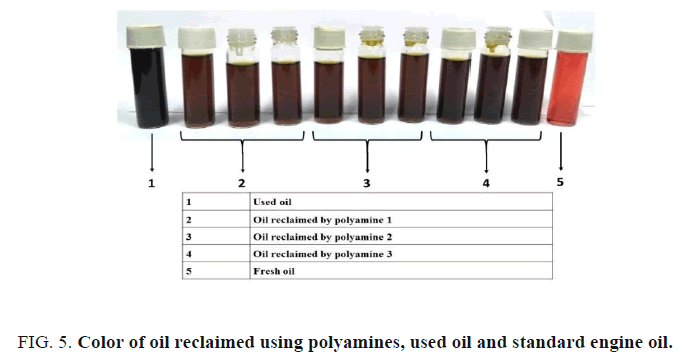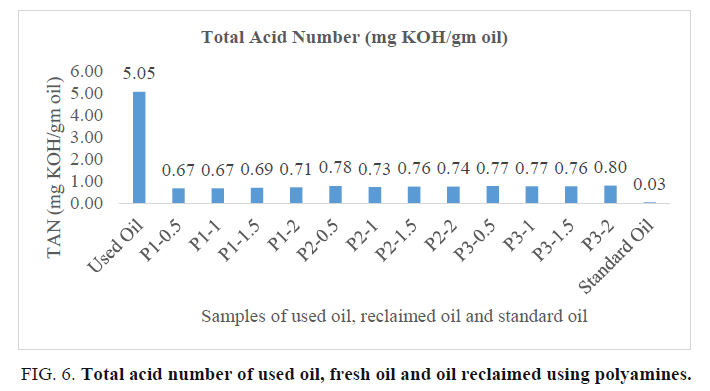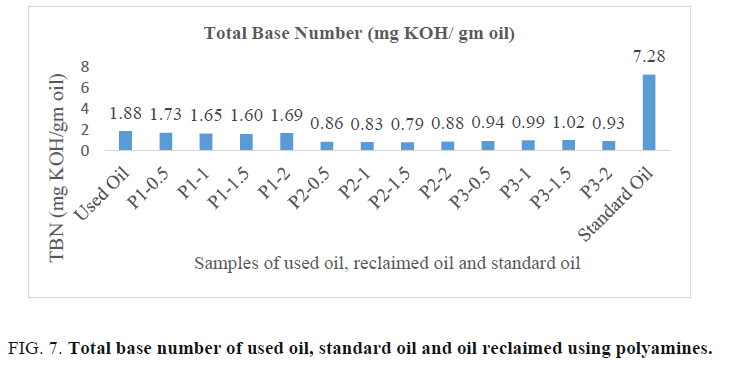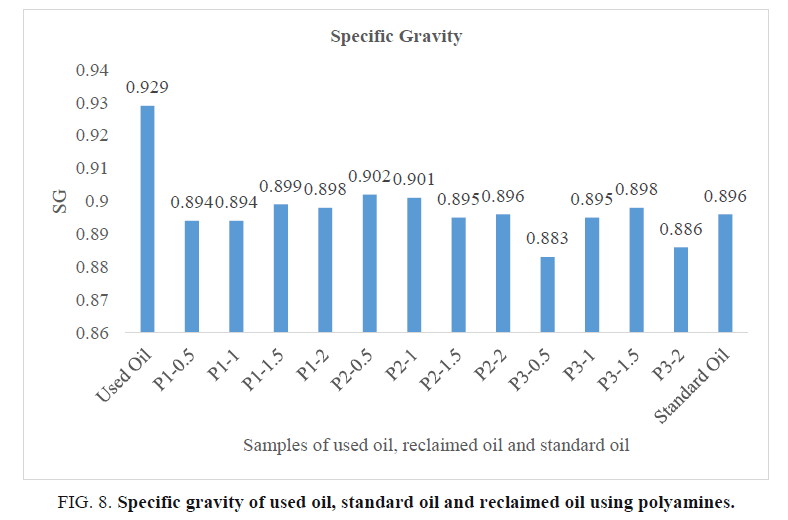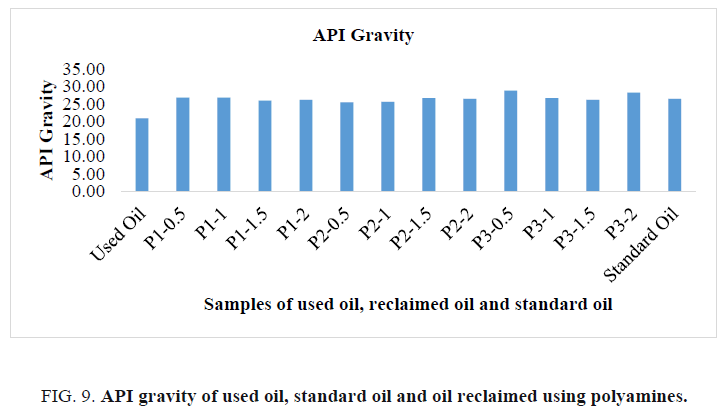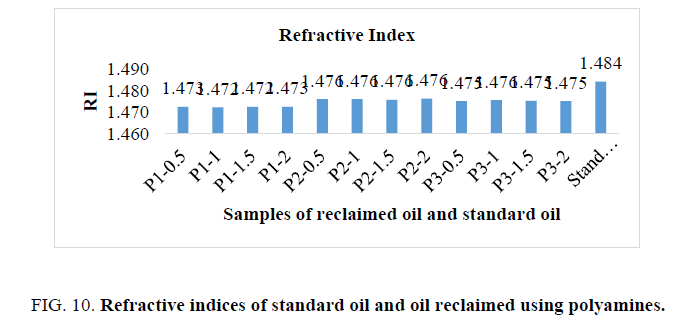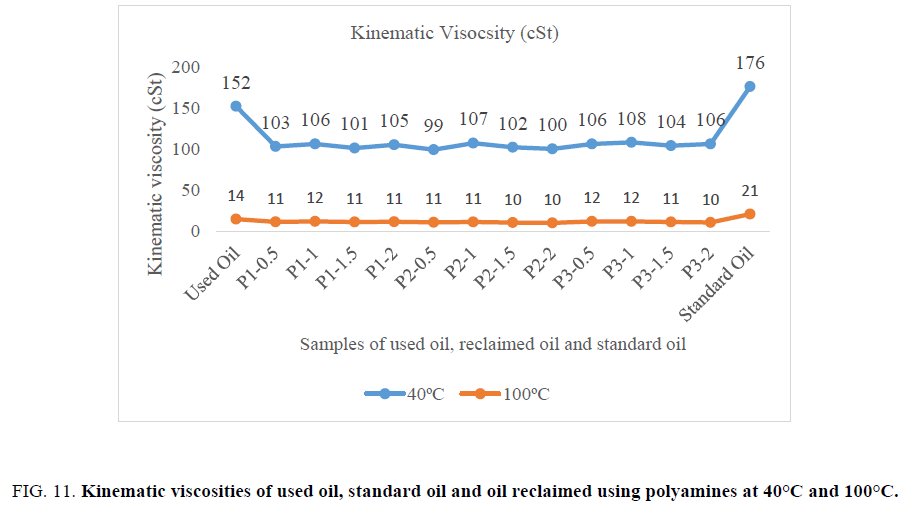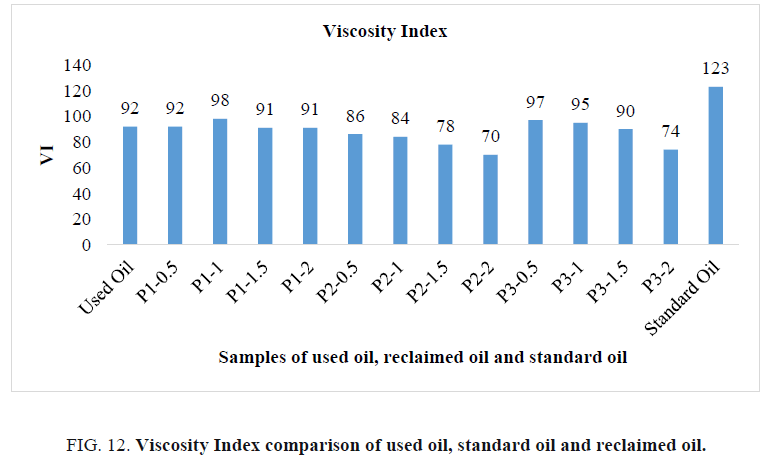Original Article
, Volume: 16( 2) DOI: 10.21767/0972-768X.1000254Reclamation of Used Engine Oil Using Polymeric Flocculants
- *Correspondence:
- ARizwan Shaikh , Department of Polymer and Surface Engineering, Institute of Chemical Technology, Matunga, Mumbai, Maharashtra, India, Tel: +91-97736 09363; E-mail: rizwanshaikh0999@gmail.com
Received: March 13, 2018; Accepted: March 19, 2018; Published: March 22, 2018
Citation: Shaikh R, Mahanwar P. Reclamation of Used Engine Oil Using Polymeric Flocculants. Int J Chem Sci. 2018;16(2):254.
Abstract
The objective of this research work was to develop a method for reclaiming the used engine oil which is time efficient, environment friendly and economical. The used oil was reclaimed using polymeric flocculants. Different cationic copolymers of polyamines like poly (adipic acid-co-epoxy propyldiethylene triamine) solution (polyamine 1), poly (dimethylamine-co-epichlorohydrin-co-ethylenediamine) solution (polyamine 2) and poly (dimethylamine-co-epichlorohydrin) solution (Polyamine 3) were used for reclaiming. The yield of oil reclaimed by using polymeric flocculants using polyamine 2 was 84% and the solvent recovered from reclaimed oil was 74%. It was observed that polymeric flocculants successfully removed the contaminants from the used engine oil. The physical and chemical properties like flash point, aniline point, color, total acid number (TAN), total base number (TBN), specific gravity and API gravity, refractive index (RI), kinematic viscosity and viscosity index of the reclaimed oil were characterized and compared with used engine oil and standard engine oil. The results indicated that all the impurities were removed from the used engine oil successfully using polymeric flocculants.
Keywords
Activated clay; Engine oil; Reclamation; Polyamine; Polymeric flocculants
Introduction
Nowadays, different automotive and industrial sectors generate huge amounts of used lubricating oils globally [1]. With the gradually increasing number of vehicles in the world, the volume of used lubricating oil produced every year is also increasing. Estimation of regional and global demands for lubricants demonstrated that Western Europe accounts for only 13% of total worldwide demand, while North America and Asia account for 22% and 30%, respectively, probably due to the widespread use of automobiles compared with other regions [2]. Management of waste oils is a growing concern, particularly in industrial and urban areas. Generation of waste oils is closely linked with an increase in the population of automobiles and industries. When additives and foreign substances, such as metal powder, chips and other particles, are mixed with lubricating oil, aging, degrading and failure will likely occur, leading to mechanical fault and degraded performance [3]. In such cases, the oil is replaced to improve the performance. The used oil, spent oil or waste oils should be collected and recycled not only to prevent the environmental pollution but also to preserve natural resources. These waste oils may have a detrimental effect on the environment if not properly handled, treated or disposed [4]. This causes a serious pollution problem and poses a threat to the environment.
The objective of this research is focused mostly on treating used engine oil so that the oil reclaimed can be used for the lubrication purpose of the engine, thereby reducing environmental pollution. For this purpose, the polymeric flocculants like polyamines were used for the separation of sludge from used oil.
Materials and Methods
Materials
Used engine oil from different garages was obtained and used as it is for the study. This oil was highly viscous, and it was completely black in color. Ethyl acetate from SD Fine Chemicals Ltd, Mumbai was used for diluting the oil and lowering its viscosity. Activated clay was obtained as a free sample from Gajre Fuller Earth Industries and it served the purpose of decoloring the oil. Different cationic copolymers of polyamines were procured from Rishabh Metals and Chemicals Pvt Ltd, Mumbai and were used as flocculating agents. Different polyamines used were:
• Polyamine 1: Poly (adipic acid-co-epoxy propyldiethylene triamine) solution
• Polyamine 2: Poly (dimethylamine-co-epichlorohydrin-co-ethylenediamine) solution
• Poly (dimethylamine-co-epichlorohydrin) solution.
Methods
Ethyl acetate was taken in a beaker and polyamine 1 was added to it. This polyamine is immiscible in EA. After adding polyamine 1, used oil was added to the EA and polyamine and it was stirred using mechanical agitator at 400 rpm for 15 minutes. The concentration of polyamine was varied as shown in the table. After the stirring was complete, it was allowed to settle down for 10 minutes. After settling, two different layers are formed, a bottom layer consisting of sludge and the upper layer was less viscous oil. The two layers formed were then separated by vacuum filtration. After filtration, the supernatant oil was treated with 20% activated clay for 15 minutes for color improvement. After treatment, the oil was centrifuged at 4500 rpm to separate activated clay and the oil solution was decanted. After decantation, EA was recovered from the oil using rotary evaporator. Temperature set for EA was 80°C and vacuum pressure applied was 40 mmHg. Similarly, the process was repeated for polyamine 2 and polyamine 3 (TABLE 1).
| Oil: Polyamine | Oil: EA | Polyamine | Sample name |
|---|---|---|---|
| 1:0.5 | 1:2 | Polyamine 1 | P1-0.5 |
| 1:1 | 1:2 | Polyamine 1 | P1-1 |
| 1:1.5 | 1:2 | Polyamine 1 | P1-1.5 |
| 1:2 | 1:2 | Polyamine 1 | P1-2 |
| 1:0.5 | 1:2 | Polyamine 2 | P2-0.5 |
| 1:1 | 1:2 | Polyamine 2 | P2-1 |
| 1:1.5 | 1:2 | Polyamine 2 | P2-1.5 |
| 1:2 | 1:2 | Polyamine 2 | P2-2 |
| 1:0.5 | 1:2 | Polyamine 3 | P3-0.5 |
| 1:1 | 1:2 | Polyamine 3 | P3-1 |
| 1:1.5 | 1:2 | Polyamine 3 | P3-1.5 |
| 1:2 | 1:2 | Polyamine 3 | P3-2 |
Table 1: Recipe for copolymers of polyamine solution and EA.
Result and Discussion
Time, yield and solvent recovery
The impurities of used oil are mostly composed of oxidation product, metallic compound, degraded additives and carbonaceous particles. These particles are in stable dispersion in used engine oil. To break this stable dispersion, flocculating agent is used and added to the solution. By the process of flocculation, particles in suspension form larger agglomerates or already formed smaller agglomerates grow in to bigger size as a result of coagulation because of high molecular weight polymeric material i.e., polymeric flocculants (FIG. 1).
Figure 1: Effect of polyamines on yield of oil recovery.
The minimum time required for reclaiming oil by polyamine treatment was 1 hour which is very less when compared with the minimum time for reclaiming oil by separation column. Thus, using polyamine for reclaiming oil is a very time efficient method.
The yield obtained by reclaiming oil using polyamine was noted to be slightly higher as compared to the separation column. Also, the solvent required for the polyamines treatment was very less as compared to the separation column, so it is cost efficient in terms of solvent consumption as well as time efficient.
Oil reclaimed using co polymer of Poly (dimethylamine-co-epichlorohydrin-co-ethylenediamine) solution i.e., polyamine 2 gave the highest yield for oil i.e., 89% for P2-1; however, the solvent recovered was only 64%. However, out of all these polyamines used, oil reclaimed by using polyamine 2 was 84% and solvent recovered was 74% for P2-0.5, which is the maximum recovery of solvent and satisfactory yield of oil. The TABLE 2 shows the yield and percentage solvent recovery using different polyamines.
| Sample name | Polyamine | Ratio | Yield (%) | Solvent recovered (%) | Duration for the process (hours) |
|---|---|---|---|---|---|
| P1-0.5 | Polyamine 1 | 1:0.5 | 87 | 68 | 1 hour |
| P1-1 | 1:1 | 84 | 73 | 1 hour | |
| P1-1.5 | 1:1.5 | 78 | 66 | 1 hour | |
| P1-2 | 1:2 | 85 | 67 | 1 hour | |
| P2-0.5 | Polyamine 2 | 1:0.5 | 84 | 74 | 1 hour |
| P2-1 | 1:1 | 89 | 67 | 1 hour | |
| P2-1.5 | 1:1.5 | 85 | 63 | 1 hour | |
| P2-2 | 1:2 | 88 | 71 | 1 hour | |
| P3-0.5 | Polyamine 3 | 1:0.5 | 77 | 65 | 1 hour |
| P3-1 | 1:1 | 74 | 69 | 1 hour | |
| P3-1.5 | 1:1.5 | 79 | 74 | 1 hour | |
| P3-2 | 1:2 | 71 | 68 | 1 hour |
Table 2: Percentage recovery of oil and solvent and time taken for reclaiming oil using polyamines.
Flash point
The flash point of used engine oil was observed to be 136°C whereas the flash point of standard engine oil was noted to be 199°C. This decrease in flash point of used engine oil is a result of contamination with fuel and oxidation products. FIG. 2 shows the comparison of flash points of oil reclaimed using polyamine with used engine oil and standard oil. The flash point of oil reclaimed by polyamine 1 was noted as 172°C, 175°C, 170°C and 172°C for P1-0.5, P1-1, P1-1.5 and P1-2 respectively. Similarly, the flash point of oil reclaimed by polyamine 2 was noted as 178°C, 171°C, 177°C and 169°C for P2-0.5, P2-1, P2-1.5 and P2-2 respectively and the flash point of oil reclaimed by polyamine 3 was noted as 184°C, 177°C, 179°C and 175°C for P3-0.5, P3-1, P3-1.5 and P3-2 respectively.
Figure 2: Flash points of used oil, reclaimed oil using polyamines and standard oil.
After reclaiming the oil, flash points were increased considerably which shows that the volatile impurities were satisfactorily removed from the oil but the flash points of all the reclaimed oils were below the flash point of the fresh lubricating oil. The decrease in value of flash point can be accredited to the presence of light ends of oil [5]. The chemistry behind this is that after undergoing combustion and oxidation at high temperature, the oil breaks down into the component part, which includes some light ends. However, flash points can be improved by adding additives to the reclaimed oil [6].
Aniline point
Aniline point indicates the presence of aromatic contents in the oil. Lower the aniline point, higher will be the aromatic contents and higher the aniline point lower will be the aromatic contents [7]. FIG. 3 shows the comparison of aniline points of oil reclaimed by using polyamines with standard oil.
Figure 3: Aniline points of reclaimed oil using polyamines and standard oil.
The aniline point of oil reclaimed by polyamine 1 was noted as 114°C,115°C,116°C and 116°C for P1-0.5, P1-1, P1-1.5 and P1-2 respectively. Similarly, the aniline point of oil reclaimed by polyamine 2 was noted as 115°C,114°C,114°C and 114°C for P2-0.5, P2-1, P2-1.5 and P2-2 respectively and the aniline point of oil reclaimed by polyamine 3 was noted as 113°C,112°C,113°C and 113°C for P3-0.5, P3-1, P3-1.5 and P3-2 respectively. However, the aniline point of used engine oil was not measured since the color of aniline and color of used engine was similar and it was difficult to identify the cloud point in a test tube.
Color
TABLE 3 shows the Gardner scale value of used engine oil, oil reclaimed by using polyamines and standard oil (FIG. 4).
| Sample | Gardner scale number |
|---|---|
| Used oil* | - |
| P1-0.5 | 17 |
| P1-1 | 17 |
| P1-1.5 | 17 |
| P1-2 | 17 |
| P2-0.5 | 17 |
| P2-1 | 17 |
| P2-1.5 | 17 |
| P2-2 | 17 |
| P3-0.5 | 17 |
| P3-1 | 17 |
| P3-1.5 | 17 |
| P3-2 | 17 |
| Standard oil | 18 |
*Used engine oil is of completely black color, so it had no comparison with the glass standards in Gardner scale
Table 3: Gardner scale number of reclaimed oil by using polyamines, used oil and standard oil.
The reason for the black color of used engine oil is carbon particles suspended in engine oil [8]. Thus, the change in color of used engine oil shows that carbon black has been successfully removed from the engine oil.
It was observed that the color obtained for the oil reclaimed by using polyamines was darker in color as compared the color obtained for the oil reclaimed by separation column. The color obtained for oil reclaimed using polyamine was dark brown showing the Gardner scale 17. However, the oil reclaimed by polyamine 3 was darker as compared to polyamine 1 and polyamine 2 as can be seen in the FIG. 5. But the value noted on the Gardner scale was 17 for the reclaimed oils by all the polyamines. The fresh oil showed the Gardner scale number as 18 since it was reddish in color. Thus, the color of used engine oil was successfully improved which shows that all the impurities were satisfactorily removed from the oil.
Total acid number
FIG. 6 shows the comparison of used engine oil, reclaimed oil and fresh oil. The TAN of used oil was found to be 5.049 mg KOH/gm oil which is much higher than the TAN of fresh oil 0.03 mg KOH/gm oil. This is due to the presence of organic, inorganic, heavy metal salts, resin, water and other corrosive material which result from the oxidation process that occurred at high temperature in the engine [9].
When polyamines were used for reclaiming used oil, it gave much lower TAN which is comparatively closer to the TAN of fresh engine oil. The TAN of oil reclaimed by polyamine 1 was observed to be 0.67, 0.66, 0.69 and 0.71 mg KOH/gm oil for P1-0.5, P1-1, P1-1.5 and P1-2 respectively. Similarly, TAN of oil reclaimed by polyamine 2 was observed to be 0.77, 0.72, 0.75 and 0.74 mg KOH/gm oil for P2-0.5, P2-1, P2-1.5 and P2-2 respectively and the TAN of oil reclaimed by polyamine 3 was observed to be 0.77, 0.77, 0.76 and 0.79 mg KOH/gm oil for P3-0.5, P3-1, P3-1.5 and P3-2 respectively. The TAN of oil reclaimed by polyamines were less than 1 which states that it is free from the oxidation products and it gave the lowest TAN value for the reclaimed oil. The TAN of oil reclaimed by polyamines were less than 1 which states that it is free from the oxidation products and it gave the lowest TAN value for the reclaimed oil.
Total base number
FIG. 7 shows the comparison of TBN value of all the oils which include used oil, all the reclaimed oils and fresh oil. The TBN of fresh oil was observed to be 7.28 mg KOH/gm oil whereas the TBN of used oil was noted be 1.88 mg KOH/gm oil. This depletion in TBN for engine oil is because the additive package added to the fresh oil was degraded during the service of this oil. The TBN value of fresh engine oil is high because the base oil is blended with a highly alkaline base package of additive to neutralize the composition of the acidic product. Higher TBN values are more effective at neutralizing the acidic products for longer duration of time [5]. The TBN values obtained for oil reclaimed using polyamines were found to be 1.73, 1.65, 1.60 and 1.69 mg KOH/gm oil for P1-0.5, P1-1, P1-1.5 and P1-2 respectively. TBN values observed were noted to be 0.86, 0.83. 0.79 and 0.88 for P2-0.5, P2-1, P2-1.5 and P2-2 respectively and 0.94, 0.99, 1.02 and 0.93 for P3-0.5, P3-1, P3-1.5 and P3-2 respectively. The TBN values of all the reclaimed oil are lower than the used engine oil which shows that any basic impurities were also removed by both the methods from engine oil. However, the TBN value of reclaimed oil can be increased by adding alkaline additives to these oils thus it can be reused for the same purpose again.
Specific gravity and API gravity
The level of impurities in the used oil is indicated by density and specific gravity. The specific gravity of used oil was 0.929 whereas the specific gravity of fresh oil was noted to be 0.896. This shows that the used oil is having the presence of oxidized and condensed products rich in carbon, metals and combination [10].
The specific gravity of oil reclaimed by polyamine 1 was observed to be 0.894, 0.894, 0.899 and 0.898 for P1-0.5, P1-1, P1-1.5 and P1-2 respectively. The specific gravity of oil reclaimed by polyamine 2 was noted to be 0.902, 0.901, 0.895 and 0.896 for P2-0.5, P2-1, P2-1.5 and P2-2 respectively and the specific gravity of oil reclaimed by polyamine 3 was noted as 0.883, 0.895, 0.898 and 0.886 for P3-0.5, P3-1, P3-1.5 and P3-2 respectively. The specific gravity of reclaimed oils was lower than the used engine oil which states the impurities like oxidized and condensed products rich in carbon, metals and combinations were successfully removed (FIG. 8).
API gravity of oils was also calculated from specific gravities. API gravities are used to classify oils as light, medium, heavy or extra heavy oil. The API of used engine oil was noted to be 20.81 which comes under the category of heavy oil because of the presence of impurities in the form of oxidized and condensed products formed by the combustion at high temperature during the service [10]. The API gravity of oils reclaimed by polyamine 1 was noted to be 26.78, 26.78, 25.90 and 26.07 for P1-0.5, P1-1, P1-1.5 and P1-2 respectively (FIG. 9).
Similarly, the API gravity of oil reclaimed by polyamine 2 were found to be 25.37, 25.55, 26.60 and 26.42 for P2-0.5, P2-1, P2-1.5 and P2-2 respectively and the API gravity of oil reclaimed by polyamine 3 was noted as 28.75, 26.60, 26.07 and 28.21 for P3-0.5, P3-1, P3-1.5 and P3-2 respectively. These values of API gravities fall into the category of medium oil, hence stating that the impurities were successfully removed. The API gravity of fresh oil was noted as 26.42. Hence on comparing the API gravities of oil reclaimed by polyamines with the API gravity of standard oil, it can be concluded that the API gravities of reclaimed oils are quite comparable to the API gravity of standard oil.
Refractive index
Refractive index of oil indicates the presence of paraffinic or aromatic compounds in the oil. RI also estimates the molecular mass of the oil. The RI of fresh oil was noted to be 1.4841 which is higher. This is due to the presence of additives like polymers, polar organic compounds and other additives. These components increase the molecular mass of the base oil and consequently it’s RI.
The RI of oil reclaimed by polyamine 1 were noted to be 1.4725, 1.4722. 1.4724 and 1.4725 for P1-0.5, P1-1, P1-1.5 and P1-2 respectively. Similarly, RI of oil reclaimed by polyamine 2 was observed to be 1.4760, 1.4760, 1.4575 and 1.4762 for P2-0.5, P2-1, P2-1.5 and P2-2 respectively and RI of oil reclaimed by polyamine 3 were 1.4751, 1.4755, 1.4752 and 1.4751 for P3-0.5, P3-1, P3-1.5 and P3-2 respectively. The decrease in RI of reclaimed oil by separation column is due to the removal of impurities caused by degradation of polymers and other additives which were added in fresh oil due to its service at high temperature [10]. However, the RI of used engine oil was not possible to measure because it was completely black and opaque. Since we can obtain RI for the reclaimed oil, it is evident that the impurities have been satisfactorily removed from the used engine oil (FIG. 10).
Kinematic viscosity
The engine oil when in service at high temperature, undergo oxidation thus producing corrosive oxidized products, deposits and varnishes which increase the viscosity [11]. The figure shows the kinematic viscosity of used oil, oil reclaimed by separation column and standard oil. The kinematic viscosity of oil at 40°C which was reclaimed by using polyamine 1 was noted as 103, 106, 101 and 105 cSt for P1-0.5, P1-1, P1-1.5 and P1-2 respectively. Whereas the viscosity of oil at 40°C reclaimed by using polyamine 2 was noted as 99, 107, 102 and 100 cSt for P2-0.5, P2-1, P2-1.5 and P2-2 respectively and the viscosity of oil reclaimed by using polyamine 3 was noted as 106, 108, 104 and 106 cSt for P3-0.5, P3-1, P3-1.5 and P3-2 respectively.
The viscosity of oil reclaimed using polyamines was found to be higher as compared to the kinematic viscosity of oil reclaimed by separation column. The viscosities were measured at 100°C also in the similar manner (FIG. 11). The kinematic viscosity of oil at 100°C which was reclaimed by polyamine 1 was noted as 11, 12, 11 and 11 cSt for P1-0.5, P1-1, P1-1.5 and P1-2 respectively. Whereas the viscosity of oil at 100°C reclaimed by using polyamine 2 was noted as 11, 11, 10 and 10 cSt for P2-0.5, P2-1, P2-1.5 and P2-2 respectively and the viscosity of oil reclaimed by using polyamine 3 was noted as 12, 12, 11 and 10 cSt for P3-0.5, P3-1, P3-1.5 and P3-2 respectively.
Figure 11: Kinematic viscosities of used oil, standard oil and oil reclaimed using polyamines at 40°C and 100°C.
The viscosity of standard oil at 40°C was observed as 176 cSt and at 100°C was observed as 21 cSt. The increase in viscosity of the standard oil is because the viscosity of base oil is increased by adding additives to it. The viscosity of used oil was observed as 152 cSt at 40°C and 14 cSt at 100°C. The increase in viscosity of used oil is due to the presence of contaminants like oxidized products, condensed products and metal particulates.
Viscosity index
The high viscosity index indicates that the viscosity of oil will change very little with the temperature, thus providing better protection to the engine operating at vast temperature range (TABLE 4).
| Sample name | Kinematic viscosity at 40°C | Viscosity at 100°C | L | H | Viscosity index |
|---|---|---|---|---|---|
| Used Oil | 152 | 14.4 | 276.3 | 141 | 92 |
| P1-0.5 | 103 | 11.1 | 176.6 | 96.45 | 92 |
| P1-1 | 106 | 11.7 | 193.3 | 104.1 | 98 |
| P1-1.5 | 101 | 10.9 | 171.2 | 93.02 | 91 |
| P1-2 | 105 | 11.2 | 179.4 | 97.71 | 91 |
| P2-0.5 | 99 | 10.5 | 160.6 | 88.95 | 86 |
| P2-1 | 107 | 10.9 | 171.2 | 93.92 | 84 |
| P2-1.5 | 102 | 10.3 | 155.4 | 86.41 | 78 |
| P2-2 | 100 | 9.9 | 145.2 | 81.67 | 70 |
| P3-0.5 | 106 | 11.7 | 193.3 | 104.1 | 97 |
| P3-1 | 108 | 11.7 | 193.3 | 104.1 | 95 |
| P3-1.5 | 104 | 11.0 | 173.9 | 95.91 | 90 |
| P3-2 | 106 | 10.4 | 158 | 87.72 | 74 |
| Standard Oil | 176 | 20.6 | 519.9 | 240.1 | 123 |
Table 4: Viscosity index of used oil, standard oil and reclaimed oil using polyamines.
The viscosity index of standard oil was observed as 123 whereas the viscosity index of used was noted as 92 (FIG. 12). The increase in viscosity index of standard oil may be because due to the presence of viscosity index improver added to the base oil. The high viscosity index means good thermal stability and low-temperature flow behaviour. The viscosity index of used oil is low because the viscosity index improver added to the base oil may have been degraded during the service at high temperature [12].
The viscosity index of oil reclaimed by polyamine 1 was noted as 92, 98, 91 and 91 for P1-0.5, P1-1, P1-1.5 and P1-2 respectively. Whereas the viscosity index of oil reclaimed by polyamine 2 was noted as 86, 84, 78 and 70 for P2-0.5, P2-1, P2-1.5 and P2-2 respectively and the viscosity index of oil reclaimed by polyamine 3 was noted as 97, 95, 90 and 74 for P3-0.5, P3-1, P3-1.5 and P3-2 respectively. However, this viscosity index of reclaimed oil can be improved by adding viscosity index improver for the final application.
Conclusion
Considering the ever-increasing scarcity and consequent high cost of petroleum, particularly high quality lubricating stocks, now presents the positive incentives to selectively remove undesirable contaminants from used oils and reuse the valuable high quality lubricating components contained in such oil. Also, environmental effect of contaminated used engine oil, it became essential to reclaiming this used engine oil for reuse. Hence, reclamation of used engine oil using polymeric flocculants was studied in terms of yield and physical and chemical properties of the oil reclaimed.
The reclaimed oil was characterized for the properties like flash point, aniline point, color, TAN, TBN, specific gravity and API Gravity, RI, kinematic viscosity and viscosity index and compared with used engine oil as well as standard engine oil. After performing all the experiments and charastierisation it can be concluded that the oil reclaimed by using polyamine 2 i.e., poly (dimethylamine-co-epichlorohydrin-co-ethylenediamine) gave the best results. The flash point of the reclaimed oil was observed as 178°C, aniline point was 115°C, TAN was observed as 0.78 mg KOH/gm of oil, TBN was noted as 0.86 mg KOH/gm of oil which were comparable with the standard engine oil. For reclaiming 1 kg used engine oil, minimum polyamine required is 500 gm which will give the best results.
References
- MS Giovanna FD, Khlebinskaia O, Lodolo A. Compendium of Used Oil Regeneration Technologies. UNIDO, 2003.
- Graziano D, Daniels E. Assessment of opportunities to increase the recovery and recycling rates of ask oils. Argonne?s Inf Publ Div. 1995.
- Lee CH, Hsu YL, Kreng VB. Analysis and comparison of regenerative technologies of waste. Trans Environ Dev. 2011;5(30):295-309.
- Andrews L. Compendium of recycling and destruction technologies for waste oils. United Nations Environment Program. 2008.
- Udonne JD. A comparative study of recycling of used lubrication oils using distillation, acid and activated charcoal with clay methods. J Pet Gas Eng. 2011;2(2):12-9.
- Danane F, Ahmia A, Bakiri A, et al. Experimental regeneration process of used motor oils. Rev des Energies Renouvelables. 2014;17(2):345-51.
- Gharagheizi F, Tirandazi B, Barzin R. Estimation of aniline point temperature of pure hydrocarbons: A quantitative structure-property relationship approach. Ind Eng Chem Res. 2009;48(3):1678-82.
- Abu-Elella R, Ossman ME, Farouq R, et al. Used motor oil treatment: Turning waste oil into valuable products. Int J Chem Biochem Sci. 2015;7:57-67.
- Eman AE, Abeer MS. Re-refining of used lube oil, i-by solvent extraction and vacuum distillation followed by hydrotreating. Pet Coal. 2013;55(3):179-87.
- Hamawand I, Yusaf T, Rafat S. Recycling of waste engine oils using a new washing agent. Energies. 2013;6(2):1023-49.
- Isah AG, Abdulkadir M, Onifade KR, et al. Regeneration of used engine oil. Energies. 2013;1:1-5.
- Katiyar V, Husain S. Recycling of used lubricating oil using 1-butanol. 2012;8(3):1999-2012.
